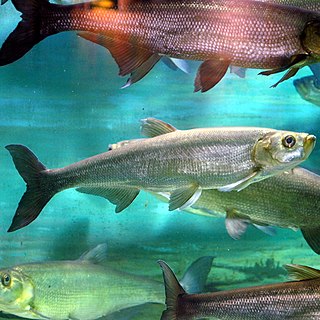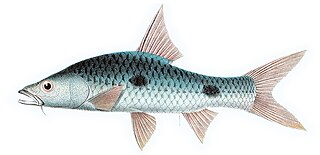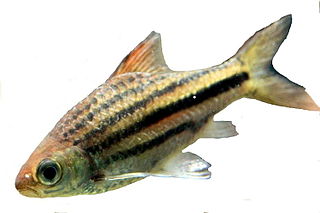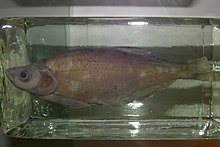
Chanodichthys is a genus of freshwater ray-finned fishes belonging to the family Xenocyprididae, the East Asian minnows or sharpbellies. The species in this genus are found in Eastern Asia. The name is derived from the Greek word chanos, meaning "abyss, mouth opened, inmensity", and the Greek word ichthys, meaning "fish". Chanodichthys is closely related to Culter and some species have been moved between these genera.

Hampala is a genus of freshwater ray-finned fish belonging to the family Cyprinidae, the family which includes the carps, barbs and related fishes. The fishies in this genus are found in South-East Asia.
Naziritor is a small genus of freshwater ray-finned fish belonging to the family Cyprinidae, which includes the carps, barbs and related fishes. The fishes in this geus are found in South Asia.
Anabarilius duoyiheensis is a species of freshwater ray-finned fish belonging to the family Xenocyprididae, the East Asian minnows or sharpbellies. This species is known only from Luoping County in Yunnan Province.
Anabarilius songmingensis is a species of freshwater ray-finned fish belonging to the family Xenocyprididae, the East Asian minnows or sharpbellies. This species is only known from southwest China, in the Yangtze river basin.
Anabarilius paucirastellus s a species of freshwater ray-finned fish belonging to the family Xenocyprididae, the East Asian minnows or sharpbellies. This species is endemic to Yunnan, in the Red River basin.
Chanodichthys abramoides is a species of ray-finned fish belonging to the family Xenocyprididae, the East Asian minnows or sharpbellies. This fish is is endemic to the southern part of the lower Amur river system, including the Sungari and Ussuririvers and Lake Khanka, in Heilongjiang and Jilin provinces in China and in Amur. Primorsky Krai and Khabarovsk Krai districts in Russia.
Chanodichthys flavipinnis is a species of freshwater ray-finned fish belonging to the family Xenocyprididae, the East Asian minnows or sharpbellies. This species is endemic to Vietnam.

The predatory carp, also known as the redfin culter or skygazer, is a species of ray-finned fish belonging to the family Xenocyprididae, the East Asian minnows or sharpbellies. This species ranges from the Amur River south to Taiwan and the Red River, as well as Lake Buir in Mongolia. It reaches 102 cm in length and 9 kg in weight.
Culter recurviceps is a species of freshwater ray-finned fish belonging to the family Xenocyprididae. This species occurs in the Pearl River and Hainan in southern China.

Aphyocypris is a genus of freshwater ray-finned fishes belonging to the family Xenocyprididae. This genus has eight valid species, all of which are restricted to East Asia.
Atrilinea is a genus of freshwater ray-finned fishes belonging to the family Xenocyprididae. This is a small genus with three valid species, all of which are endemic to China.

Bangana is a genus of fish in the family Cyprinidae, the carps and minnows. It is distributed across much of southern and eastern Asia. Species live mainly in the flowing waters of tropical and subtropical rivers.

Candidia is a genus of freshwater ray-finned fishes belonging to the family Xenocyprididae. This is a small genus with two valid species, all of which are endemic to Taiwan.

Chagunius is a genus of freshwater ray-finned fish belonging to the family Cyprinidae. which includes the carps, barbs and related fishes. The fishes in this genus occur in South and Southeast Asia.
Elopichthys is a monospecific genus of freshwater ray-finned fish belonging to the family Xenocyprididae, the East Asian minnows or sharpbellies. The only species in the gneus is Elopichthys bambusa, the yellowcheek or kanyu, a large fish that is found in freshwater habitats in eastern Asia. It ranges from the Amur River in Russia, through China to the Red and Lam Rivers in Vietnam. It prefers relatively warm waters, entirely avoiding colder highlands. It is considered an important food fish where it occurs, reaching up to 2 m in total length and 52.2 kg (115 lb) in weight.
Hainania serrata, also known as the Hainan minnow, is a species of freshwater ray-finned fish belonging to the family Xenocyprididae. the East Asian minnows or sharpbellies. This fish is found in fast flowing hill streams in southern China and Vietnam. It is the only member of the genus Hainania.

Striuntius is a genus of freshwater ray-finned fishes belonging to the family Cyprinidae, the family which includes the carps, barbs and related species. The fishes in this genus are found in Southeast Asia.
Ancherythroculter lini is a species of freshwater ray-finned fish belonging to the family Xenocyprididae, the East Asian minnows or sharpbellies. This species is found in the Zhujiang River in China and was described in 1994. The specific name honours the Chinese ichthyologist Lin Shu-Yen.
Aphyocypris kikuchii is a species of freshwater ray-finned fish belonging to the family Xenocyprididae, the East Asian minnows or sharpbellies. It is endemic to Taiwan. It is a benthopelagic freshwater fish that grows to 8 cm (3.1 in) total length.







